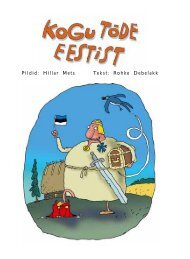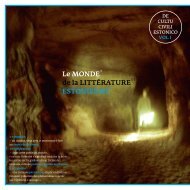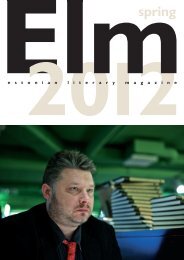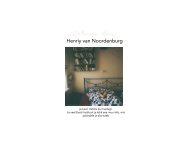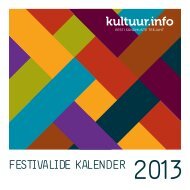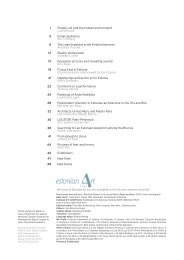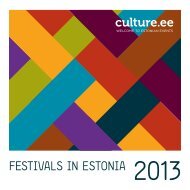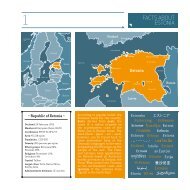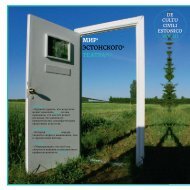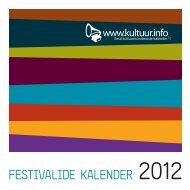Autumn 2013
Autumn 2013
Autumn 2013
You also want an ePaper? Increase the reach of your titles
YUMPU automatically turns print PDFs into web optimized ePapers that Google loves.
exceptions, the cultural elements that<br />
Kivirähk draws upon are not specifically<br />
Estonian. As far as the legendary elements<br />
are concerned, the Salamander reminds one<br />
of Fafnir, the Nordic dragon, well known in<br />
France through one of Wagner’s operas, and<br />
Gaul was full of hiied: sacred groves! On<br />
another level, the villages described in the<br />
book, are very similar to those which existed<br />
in France during the Middle Ages. Conflict<br />
between Paganism and Christianity also<br />
took place in France, and the hatred of<br />
snakes by religious bigots is equally familiar.<br />
The depiction of bears as comic characters,<br />
could have been taken directly from Roman<br />
de Renart, one of the medieval texts best<br />
known to the general public. Even the<br />
conflict between common people and a<br />
nobility, created from warriors and the<br />
religious orders, is familiar to us. Of course,<br />
our nobility spoke the same language as the<br />
people but it also claimed to have come from<br />
Germany, at the time of great invasions; and<br />
there have been three more invasions by<br />
Germany since 1870. Kivirähk’s anticlericalism<br />
is regarded as rather banal in France,<br />
probably more so than in Estonia.<br />
Only in a few, specific places within Kivirähk’s<br />
text were explanatory notes required,<br />
(for example, to explain what a kiik is). Many<br />
more would have been required had the<br />
original text been from a Mexican or Arabic<br />
author. But that is to be expected; Estonia is<br />
part of Europe! Estonians are not a band of<br />
prehistoric people miraculously preserved on<br />
a reservation, nor are they a tribe isolated on<br />
an island; their culture is entirely European and,<br />
over millennia, has evolved by contact with<br />
other European cultures. That their language<br />
is not Indo-European is mere detail, which is<br />
lost in translation, anyway.<br />
In fact, Kivirähk addresses omnipresent<br />
issues with a blend of deftness and gravity<br />
which is characteristic of the age we live in:<br />
how do we adapt to the passage of time, to<br />
the modern world, without becoming bigots<br />
trapped in an idealised past? How do we<br />
accept that what we take for granted is<br />
disappearing? How might we live in the<br />
midst of stupidity? How might we confront<br />
loneliness? That these problems are being<br />
addressed by a society, some distance<br />
away, does not put off a well-read, French<br />
reader who is in the habit of enjoying works<br />
by Japanese, Hindu or other authors. In any<br />
case, Leemet lives in a country of fairy tales<br />
and science fiction which is much more<br />
familiar than is Estonia. The only aspect of<br />
the book that may be a little curious for a<br />
French reader is the way in which Kivirähk<br />
places emphasis on the problem of languages.<br />
(In France there is little mention of<br />
linguistic conflicts; some French people are<br />
even quite happy to see lesser-spoken<br />
languages disappear). But the book is so<br />
magnificent that it is possible to ignore this<br />
issue whilst deriving so much pleasure from<br />
reading the book as a whole.<br />
Kivirähk’s humour relies very little on wordplay;<br />
it is a mix of burlesque, situation comedy<br />
and, in particular, a sense of anachronism, familiar<br />
to those who grew up with Kamelot and<br />
Monty Python. It is, quite simply, an absorbing<br />
read! There is never a dull moment.<br />
For me, the adventure is over. Will there<br />
be a follow-up? Not immediately. Kivirähk’s<br />
next book to appear in France, Rehepapp,<br />
will be translated by Antoine Chalvin (with<br />
publication planned for the <strong>Autumn</strong> of 2014).<br />
Furthermore, other intellectual challenges<br />
have arisen in addition to translating from<br />
Estonian. For several years I have been<br />
struggling to learn the Basque language, the<br />
only European language, other than the<br />
Finno-Ugric languages, which differs so<br />
much from French, and which also excites<br />
my interest. So, what about a comparative<br />
study of the prospects for the Basque and<br />
Estonian languages, and for the Basque<br />
region and Estonia? They demonstrate<br />
many similarities but also many differences?.<br />
What about a translation from Basque into<br />
Estonian or the promotion in the Basque<br />
Country of one of Kivirähk’s books translated<br />
into Basque?<br />
Let us dream...<br />
Translated from French by Gwyn Davies



